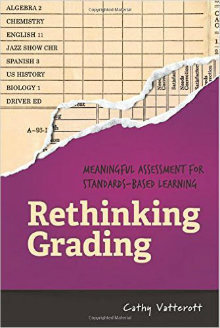Why We Need to Rethink Grading Practices
Rethinking Grading: Meaningful Assessment for Standards-Based Learning
By Cathy Vatterott
(ASCD, 2015 – Learn more)
Reviewed by Michael DiClemente
 If you are a teacher, it’s inevitable that you have been involved in conversations about grading practices. Just recently I attended a department meeting where we were talking about assessment of student work, using rubrics, and how to grade writing assignments.
If you are a teacher, it’s inevitable that you have been involved in conversations about grading practices. Just recently I attended a department meeting where we were talking about assessment of student work, using rubrics, and how to grade writing assignments.
The conversation with my fellow teachers took an unexpected turn when we began to talk about a student’s behavior and effort in relation to assessing their work. As a newer teacher I did not really voice my opinion, but I couldn’t help but look at the rubric and think there is no section for a good kid who tried hard.
 Cathy Vatterott uses the first chapter of her book to look at current grading practices. She discusses the history of grading and the notorious bell curve. One of the ideas that really left an impression on me, especially because after much contemplation I realized it is true, is that the current use of grades “has led to a school culture that often places more value on compliance and working than learning.”
Cathy Vatterott uses the first chapter of her book to look at current grading practices. She discusses the history of grading and the notorious bell curve. One of the ideas that really left an impression on me, especially because after much contemplation I realized it is true, is that the current use of grades “has led to a school culture that often places more value on compliance and working than learning.”
In the traditional grading paradigm, when teachers grade everything, the grade means nothing. When teachers combine so many things into one rating, many nonacademic factors cloud the grade – the picture becomes muddy and not reflective of learning.”
As the book continues, Vatterott shares reasons why we need a new grading system. This is a difficult pill to swallow, mostly because she’s calling for drastic change in a practice that is deeply embedded in the traditional education system. But it’s hard to ignore her arguments.
What is the purpose of grading?
One of the first things Vatterott has us ask ourselves is “what is the purpose of grading?” It seems obvious as we discuss this that it is a measure of student learning. However, when we look at actual grading practices, we notice a fairly common trend; much of our grading is based on behavior, student effort, and, let’s be honest, sometimes whether we like the student. This of course should not be the case.
Teachers have choices. We can stop grading everything students do. Learning tasks can be graded, monitored, or given feedback without grades. Grades are not necessary for learning, but feedback is. In fact, feedback has been shown to be one of the most effective strategies to improve learning. Student progress and mastery are driven by nonpunitive feedback.”
So, what does standards-based grading look like? Not everything should be graded and grades should not be affected by behavior. Our measures of student progress should be based on a series of non-punitive formative assessments that allow students to try and fail.
When the student is ready, a summative assessment is done to show learning. Deficiencies in learning can be made up with a clear plan of action agreed upon by student and teacher. It is the summative assessment that is the grade.
A fundamental shift in grading
As you can see, this system changes school is some very fundamental ways. Convincing students, teachers, administrators, parents to buy in will be very difficult. In the current system, for example, students can be penalized (down-graded) for not doing homework even if they perform very well on assessments. On the other hand, in this new grading system we will have to instill in students the value of completing assignments that aren’t “graded,” but are essential for moving forward in our learning.
It is critical that students see the relationship between feedback, formative assessment, and summative assessments as progressive.”
The fourth chapter of the book, “What, How, and When to Grade,” is the real heart of the theory. If you read just this chapter, you may be feeling a bit overwhelmed by the whole process. The information in this chapter addresses the real crux of the issue: the need to change perceptions around grading so that students (and parents) realize that every assignment before the summative assessment has value because it is preparing the student with the skills necessary to meet the standards being put forth in the final assessment.
Homework and retakes
I will not discuss what is said about homework because you can go to Vatterott’s previous work on the subject. However, I will briefly mention what is stated about “retakes” because the analogy used is one of my favorites in the book. Vatterott writes: “Drivers are not restricted by how many times they took the driver’s test and their scores are not averaged together. A lawyer’s license to practice law does not indicate how many times he or she took the bar exam.”
The same analogy works for teachers’ exams as well. I know we all work with some great teachers who did not pass the exams their first time around. Imagine if that great teacher was denied the opportunity to work with children because “retakes” were not allowed.
Upgrading our grading practices will be very challenging
The final chapter leaves the reader with an idea of what standards-based grading will look like and how to integrate it into their practice. Vatterott gives both success stories and some cautionary tales. She gives no false hopes of a system that is perfectly executed by all. What the reader is left with is the notion that education is a dynamic and fluid field that must use the available research to better serve our students.
A revolution in education is happening. Teachers and administrators are reexamining grading practices and thinking outside the box like never before.”
With that said I must say that this system requires immense support by teachers, administrators, and support staff in order for it to work in a school. I can not fully envision how standards-based grading is implemented on a day-by-day basis, and would love the opportunity to spend some time in a district as an observer to see what this looks like in practice.
As an educator who strives to use research-based strategies to effectively teach all my students and have them succeed, I recommend reading this book. Rethinking Grading has us do something we all need to do: think and reflect about our practice.
Michael DiClemente is a sixth grade Social Studies teacher at the Andrews Middle School in Medford, Massachusetts. Michael has a master’s degree in history and is involved in the local historical community. Michael has become increasingly involved in the National Council for the Social Studies and the Massachusetts Council for the Social Studies, and is currently coordinating efforts to restart the Merrimack Valley Council for the Social Studies. Check MiddleWeb for Michael’s other reviews.

































